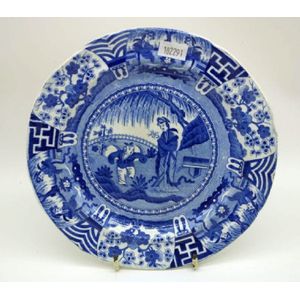Hunter River Steam Navigation Co. Porcelain Dish
You must be a subscriber, and be logged in to view price and dealer details.
Subscribe Now to view actual auction price for this item
When you subscribe, you have the option of setting the currency in which to display prices to $Au, $US, $NZ or Stg.
- Transfer Printed / Decorated Transferware - Transfer printing is method of decorating ceramics, reducing the cost of decoration when compared to employing artists to paint each piece. A print was taken on transfer-paper from an engraved copperplate, covered in ink prepared with metallic oxides, and the image on the paper was then applied to the biscuit-fired ceramic body. The print was fixed by heating the object in an oven, and then glazed, sealing the picture. Early transfer prints were blue and white, as cobalt was the only colour to stand firing without blurring. Early in the 19th century advances in the composition of the transfer paper resulted in better definition and detail, and enabled engravers to combine line-engraving with stipple.
- Circa - A Latin term meaning 'about', often used in the antique trade to give an approximate date for the piece, usually considered to be five years on either side of the circa year. Thus, circa 1900 means the piece was made about 1900, probably between 1895 and 1905. The expression is sometimes abbreviated to c.1900.
Visually similar items

Early Qing export ware plate Kangxi to Yong Zheng period, decorated with flowers & birds. Diameter 22 cm

Chinese blue and white porcelain charger, decorated with peony and foliage, border of scrolling motif to interior and border of Greek key to exterior, six character mark to rim of exterior, diameter 42 cm

Spode 'Lange Lijsen' pattern side plate, Impressed mark and printed mark and Butcher collection label to base. Diameter 18 cm

Chinese 19th century blue & white porcelain bowl, depicting 2 figures surrounded by an ornate border, 26.8 cm diameter, 4.4 cm high
